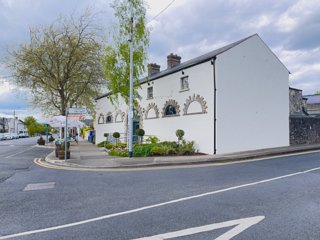MORE ABOUT THE COACH HOUSE
Palmerstown Village, a Dublin suburb, boasts a rich industrial, historical, and architectural heritage. Unfortunately, some significant sites remain privately owned and inaccessible to the public. One intriguing exception is The Coach House @Stewarts, a fascinating blend of historic charm and modern purpose, which proved surprisingly difficult to find information about online.
History of The Coach House
Originally a genuine coaching inn along the primary Dublin to Galway road, The Coach House offers a glimpse into the village's past. After an extensive renovation in 2004, and a brief closure in 2023, it now proudly showcases a crafts and coffee shop while importantly providing sheltered employment opportunities for people with learning disabilities.
Stewarts Care: A Cornerstone of Palmerstown
The Coach House @Stewarts has strong ties with Stewarts Care, formerly known as Stewarts Hospital. Founded in 1869 by Dr. Henry Hutchinson Stewart, Stewarts Care originally specialised in education and support for children with mental handicaps. Today, it's a leading voluntary organisation that provides a wide array of community-based services for people with intellectual disabilities, championing their dignity, well-being, and pursuit of happiness.
Stewarts Care and Palmerstown Village enjoy a mutually beneficial relationship. As a prominent local employer and service provider, Stewarts Care deeply enriches the community, which in turn has steadfastly supported its work over the years.
The Coach House: Social Enterprise in Action
The Coach House @Stewarts on Mill Lane exemplifies social enterprise, providing impactful training opportunities for people with learning disabilities. This initiative underscores the close relationship between Stewarts Care and Palmerstown Village, reflecting their shared commitment to fostering inclusion and community development.
The Significance of Coach Houses in Ireland
Historically, coach houses played a vital role on Irish estates during the 18th and 19th centuries, serving as stables, coach storage, and occasionally living quarters for staff. Figures like Charles Bianconi, an Italian immigrant, revolutionised Irish transport in the early 19th century with his vast network of open carriages, outcompeting many existing mail coaches.
History of The Coach House
Originally a genuine coaching inn along the primary Dublin to Galway road, The Coach House offers a glimpse into the village's past. After an extensive renovation in 2004, and a brief closure in 2023, it now proudly showcases a crafts and coffee shop while importantly providing sheltered employment opportunities for people with learning disabilities.
Stewarts Care: A Cornerstone of Palmerstown
The Coach House @Stewarts has strong ties with Stewarts Care, formerly known as Stewarts Hospital. Founded in 1869 by Dr. Henry Hutchinson Stewart, Stewarts Care originally specialised in education and support for children with mental handicaps. Today, it's a leading voluntary organisation that provides a wide array of community-based services for people with intellectual disabilities, championing their dignity, well-being, and pursuit of happiness.
Stewarts Care and Palmerstown Village enjoy a mutually beneficial relationship. As a prominent local employer and service provider, Stewarts Care deeply enriches the community, which in turn has steadfastly supported its work over the years.
The Coach House: Social Enterprise in Action
The Coach House @Stewarts on Mill Lane exemplifies social enterprise, providing impactful training opportunities for people with learning disabilities. This initiative underscores the close relationship between Stewarts Care and Palmerstown Village, reflecting their shared commitment to fostering inclusion and community development.
The Significance of Coach Houses in Ireland
Historically, coach houses played a vital role on Irish estates during the 18th and 19th centuries, serving as stables, coach storage, and occasionally living quarters for staff. Figures like Charles Bianconi, an Italian immigrant, revolutionised Irish transport in the early 19th century with his vast network of open carriages, outcompeting many existing mail coaches.

MORE ABOUT THE COACH HOUSE